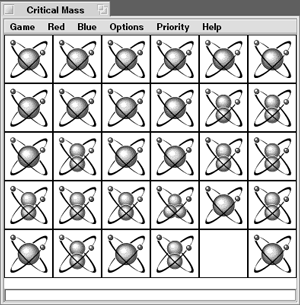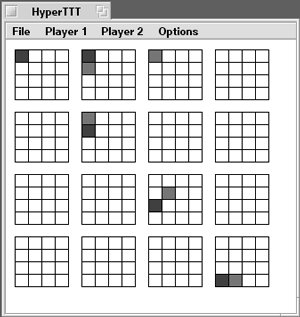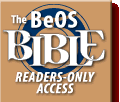|
|
|||||||||||||||||||||||||||||||||||||||||||||
| Section 1 |
Action Games |
| Section 2 |
Arcade Games |
Section 3 |
Board Games
|
Terminal-Based Games Chapter Summary |
||||||||||||||
| Figure 8 Critical Mass lets you leverage the power of chain reactions to vanquish your atomic opponent. |
 |
| Use the Options menu to play on a wraparound or torus-shaped board! |
Desdemona
Grayson Myers' Desdemona is simply a freeware version of the classic board game Othello for BeOS. If you've read Shakespeare's Othello (and you should), you'll appreciate the title of this classic game of black and white. The objective is simple, the play is fascinating: Discs have two faces, one black and one white. Players take turns placing discs on the grid. If a disc is placed such that one a player's discs lies between two of their opponent's, that disc is flipped, changing it to the opposite color. The hitch is that such a play is the only legal move. If you can't flip one of your opponent's discs, you must pass on your turn. When neither player can move, the discs are counted, and the player with the most discs of their color facing up wins.
You can play Desdemona against another human or against the computer (use the Game menu to select an opponent). You can also specify the intelligence level of the computer, or use the Custom setting to tell the computer to look an arbitrary number of moves ahead or to set the number of moves before the end of the game.
HyperTTT
Brian Nenninger's HyperTTT is a multidimensional derivative of tic-tac-toe--a game that is "easy in two dimensions, a bit more challenging in three, and pretty annoying in four or more." Since it's tough to represent four dimensions on a 2D monitor, HyperTTT represents higher dimensions with separate 2D grids. This may prove a little confusing at first, but by experimenting with different dimensionalities via the Dimensions section of the Options menu, you'll get the hang of it before too long.
| Figure 9 Move tic-tac-toe into the fourth dimension with HyperTTT. Shown: HyperTTT gets around the inability of 2D monitors to display four dimensions by laying out your game on parallel grids. |
 |
Noughts and Crosses
So you think you're a master of tic-tac-toe? Why not raise the stakes and play on a larger grid? Rather than the standard 3x3 grid of standard tic-tac-toe, Claes Löfqvist's Noughts and Crosses gives you a 50x50 grid in which to work, and challenges you to get any five pieces in a row. The game can be played either against another human or against the computer. Just use the controls on the right side to establish who gets to draw Os and who draws Xs. If you're playing against the computer, though, be forewarned: Unless you're a real pro, you probably don't stand much of a chance--the program's algorithms are very smart (which is another way of confessing that we were never able to beat the machine).
| In Sweden, this popular game is called Luffarschak, or "Tramp Chess." |
| You can have the computer play both Xs and Os. Click New Game and watch the program take itself on; it usually beats itself within 30 moves. |
As with several of the games covered in this chapter, you'll probably want to set your screen resolution to 800x600 or lower to avoid eyestrain--the grid is very tiny.
SimCity 3000
If you're a fan of realistic systems simulation, you're no doubt familiar with Electronic Arts' famous "Sim" series, including SimCity, SimWorld, SimOcean, and SimLife. At Comdex 1998, Electronic Arts demonstrated SimCity 3000 running on BeOS for the first time. The game should be available in early 1999.
SimCity is a completely different kind of game. Rather than trying to destroy as much as you can, the goal of this game is actually to build things up (what a novel concept!). You begin the game with a budget and a predefined collection of resources, pick a hunk of land, and start building. Mere money does not a city make, however--you'll have to do some thinking. Position your factories too far from the river and they'll have no place to dump their toxic waste. Fail to put enough money into the power grid and your citizens will end up in the dark. Upset enough citizens and they'll revolt. Situate your office buildings too close together and you'll end up with traffic jams. Building cities is a delicate process of balancing natural and human resources, and you'll be amazed by the realism built into the game. You might even come out of your first few sessions with a whole new respect for your own municipal leaders.
One of the most fascinating aspects of the Sim series is the fact that the games "iterate" over time. Shut down your machine, come back tomorrow, and babies will have been born. Oops--you might have to build another school. Earthquakes happen, as do parades and vandalism. As with a real city, some factors you can control, and others are just part of the game of life.
Terminal-Based Games
One of the things about graphical games is that all the wild 3D effects and thundering sounds can distract you from what really matters: the gameplay. Say what you will about command-line games, but the better ones definitely put imagination first, and isn't that what it's really about?
Amylaar LPMud
Multiuser dungeons, or MUDs, are environments that exist purely through the powers of description of the people who roleplay within them. No graphics, no audio--just people taking on roles, conversing in a context described by text files alone. Despite the name, not all MUDs are dungeons. In fact, most aren't.
MUDs are typically run on a school or institution's hardware and accessed by players via telnet. Thanks to the telnet client built into BeOS, you can host the Amylaar LPMud directly on your BeOS machine, and stop abusing shell accounts.
Lars Duening's port of the classic LPMud game driver (originally written by Lars Pensjoe) does not include a mudlib, though the standard 2.4.5 and 3.x series should work fine. Just grab the source code from the above location and compile (see Appendix D for details). This package assumes familiarity with the specifics of MUD configuration.
Dworkin's Game Driver
DGD is a second-generation driver for LPMud (above), written by Felix Croes. Several popular MUDs have run DGD over the years, including the legendary Igor (telnet://phronesis.algonet.se:1701). While you can install DGD anywhere you like, you'll have to change the "directory" parameter in mud.dgd to match your actual path. Start the driver by typing:
bin/DGD mud.dgd
The driver will then start listening on ports 6047 and 6048, so as long as your BeOS telnet server is running, users will be able to play the game by accessing telnet://your.ip.address:6047, for example.
Gameplay, as you can see in the DGD login sequence below, is radically different from the graphical environment of the action games described elsewhere in this chapter. Even though the game is text-based, however, an atmosphere and context is established as soon as you contact the server.
$ telnet phronesis.algonet.se 1701
Trying 194.213.74.173...
Connected to phronesis.algonet.se.
Escape character is '^]'.
... intercepted transmission 981101:20:143, crossref to project LPMud ...
Name: IgorMud.
Classification: Juvenile subversion installation, grade "Puce, level A".
Prime Suspect: Codename Strider "Larch" Strider.
Other Suspects: Codenames Patricus, Lazuli, Xyppe, Zellski.
Originator: Codename Spix.
NME agents: On Que (deceased).
Location: Close to former Red Russia, on the east coast of Sweden.
Restrictions: Internal playerkilling only allowed in the room called
"arena", south of the church.
... intercepted transmission 981101:20:143 ends ...
Please keep your eyes no further than 9 centimeters from the screen while typing your name, in order for the retina scan to secure your identity. Running DGD 1.1.44. Type "users" to see the current list of players.
Type "finger player" to request information about a player.
What is your name: keitolainen
Chapter Summary
- Without question, BeOS has all the guts and technology it takes to become a mind-blowing gaming platform. However, its true potential won't really shine until a next-generation game is developed as native BeOS software, rather than as a port of an existing game to BeOS. At this writing, most BeOS games were ports.
- The action game category pushes both hardware and players' brainstems to the limits. Wildcard Design has ported a number of games to BeOS from other platforms, including Abuse, Axia, and Doom. Nerdkill is a bizarre game involving nothing more than the destruction of hordes of swarming cartoon nerds.
- Quake for BeOS does exist, but as of R4.0 had never been seen outside Be's office walls. When the formalities have been cleared up, don't be surprised to see the port offered to the public.
- Dozens of classic arcade games exist in BeOS versions, including Acid Tetris (a trippy Tetris variant), BePac Deluxe (a new take on the Pac-Man theme), and Roll 'm Up (a fast-action pinball game centered on a beer theme).
- Likewise, you'll find dozens of BeOS board games on BeWare, including Critical Mass (proton overload is your only weapon), Desdemona (a version of Othello), and the multidimensional HyperTTT, which lets you play tic-tac-toe in four dimensions.
- Electronic Arts will bring SimCity 3000 to BeOS in the first quarter of 1999, so you can build a city of your own from scratch. Just keep those unions in check, eh?
- There are a number of Terminal-based games for BeOS, and you can even use BeOS's built-in telnet server to host multiuser dungeons (MUDs) of your own.
| <<previous |
|
 |
 |
Please direct technical questions about this site to webmaster@peachpit.com.
Copyright © 1999 Peachpit Press and the respective authors.
